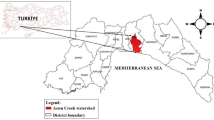Abstract
This paper shows the output of a research study that involves developing a new model for diffuse source pollution requiring the integration of a complex distributed catchment model with a model of contaminant transport. It explains in details the various model components, modifications and assumptions that have been made in the construction of the new combined model (NCM) based on Hydrological modules of Hydrological Simulation Program FORTRAN (HSPF) and Phosphorus transformations modules of Soil and Water Assessment Tool (SWAT) model, as well as the approach adopted. Three Irish catchments have been tested, namely Oona, Bawn and Dripsey. Model performance for both calibration and validation periods, and model parameter sensitivity and uncertainty analysis results were examined extensively with the outputs of SWAT model and HSPF. The NCM showed promising potential for better estimation of phosphorus losses from catchments for Irish conditions with some drawback for baseflow dominant catchments. It gives good results in terms of flow and phosphorus modelling, and is generally better than SWAT or HSPF alone for most of the cases tested. An uncertainty analysis based on model parameters was conducted using the PARASOL method implemented in SWAT 2005, and uncertainty bounds for the flow and the total P load predictions were compared with the observed values for each catchment.







Similar content being viewed by others
References
Ali IS (2010) Improved semi distributed modeling of Phosphorus losses from catchment. PhD Thesis, National University of Ireland, Dublin
Allen RG, Jensen ME, Wright JL, Burman RD (1989) Operational estimates of evapotranspiration. Agron J 81:650–662
Arnold JG, Srinivasan R, Mttiah RS, Williams JR (1998) Large area hydrologic modelling and assessment part I: model development. J Am Water Resour Assoc (JAWRA) 34(1):73–89
Bicknell BR, Imhoff JC, Kittle Jr JL, Jobes TH, Donigian Jr AS (2001) Hydrological Simulation Program – FORTRAN (HSPF). User’s manual for release 12U.S. EPA National Exposure Research Laboratory, Athens, GA, in cooperation with U.S. Geological Survey, Water Resources Division, Reston, VA
Duan Q, Gupta VK, Sorooshian S (1992) Effective and efficient global optimisation for conceptual rainfall-runoff models. Water Resour Res 28:1015–1031
Eckhardt K, Haverkamp S, Fohrer N, Frede HG (2002) SWAT-G a version of SWAT99 modified for application to low mountain range catchments. Phys Chem Earth 27(9/10):641–644
Hargreaves GH, Samani ZA (1985) Reference crop evapotranspiration from temperature. Appl Eng Agric 1:96–99
Kim NW, Chung IM, Won YS, Arnold JG (2008) Development and application of the integrated SWAT-MODFLOW model. J Hydrol 356:1–16
Mathevet T, Michel C, Andreassian V, Perrin C (2006) A bounded version of the Nash-Sutcliffe criterion for better model assessment on large sets of basins. In: Large sample basin experiments of hydrological model parameterization: results of the model parameter experiment-MOPEX. IAHS Red Book Publication no. 307, pp. 211–219
McDonald MG, Harbaugh MG (1988) A modular three-dimensional finite-difference ground water flow model. United State Geological Survey, Techniques of Water Resources Investigation Book 6, Chapter A1 pp. 586
Mockler E, O’Loughlin F, Bruen M (2016) Understanding hydrological flow paths in conceptual catchment models using uncertainty and sensitivity analysis. Comput Geosci 90B:66–77
Moriasi DN, Arnold JG, Van Liew MW, Bingner RL, Harmel RD, Veith TL (2007) Model evaluation guidelines for systematic quantification of accuracy in watershed simulations. Trans ASABE 50(3):885–900
Nasr A (2004) Modelling of phosphorus loss from land to water: a comparison of SWAT, HSPF and SHETRAN/GOPC for three Irish catchments. PhD Thesis, National University of Ireland, Dublin
Nasr A, Bruen M (2005) Eutrophication from agricultural sources: a comparison of SWAT, HSPF and SHETRAN/GOPC phosphorus models for three Irish catchments (2000-LS-2.2.2-M2) Main Report
Priestley CHB, Taylor RJ (1972) On the assessment of surface heat flux and evaporation using large-scale parameters. Mon Weather Rev 100:81–92
Singh JH, Knapp V, Demissie M (2004) Hydrologic modeling of the Iroquois River watershed using HSPF and SWAT, Illinois State Water Survey contract Report 2004–08
Sophocleous M, Perkins SP (2000) Methodology and application of combined watershed and ground water models in Kansas. J Hydrol 236(3–4):185–201
Van Griensven A, Bauwens W (2003) Multiobjective autocalibration for semi-distributed water quality models. Water Resour Res 39(12):1348–1356
Zhaling L, Shaoc Q, Xub Z, Caib X (2010) Analysis of parameter uncertainty in semi-distributed hydrological models using bootstrap method: a case study of SWAT model applied to Yingluoxia watershed in northwest China. J Hydrol 385(1–4):76–83
Acknowledgments
This paper forms part of the first author’s Ph.D. dissertation at the University College Dublin which was supported by a Teagasc Walsh Fellowship and by UCD’s Centre for Water Resources Research. In addition, we acknowledge the partial support of the National Training Directorate (Sudan) for funding the final 2 years of the PhD studies. An initial version of this paper has been presented at the 9th World Congress of the European Water Resources Association (EWRA) “Water Resources Management in a Changing World: Challenges and Opportunities”, Istanbul, Turkey, June 10–13, 2015.
Author information
Authors and Affiliations
Corresponding author
Rights and permissions
About this article
Cite this article
Ali, I., Bruen, M. Methodology and Application of the Combined SWAT-HSPF Model. Environ. Process. 3, 645–661 (2016). https://doi.org/10.1007/s40710-016-0167-x
Received:
Accepted:
Published:
Issue Date:
DOI: https://doi.org/10.1007/s40710-016-0167-x




